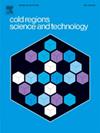Enhancing artificial permafrost table predictions using integrated climate and ground temperature data: A case study from the Qinghai-Xizang highway
IF 3.8
2区 工程技术
Q1 ENGINEERING, CIVIL
引用次数: 0
Abstract
The complexities of permafrost changes, driven by climate warming and engineering activities, coupled with challenges in data acquisition, make it crucial and challenging to accurately predict the artificial permafrost table, particularly for subgrades in high-temperature unstable permafrost regions. To address this, this study developed a hybrid machine learning model (RF-LSTM-XGBoost) for permafrost table prediction. By analyzing climate change and ground temperature data from various positions and depths along the subgrade in the Tuotuo River section of the Qinghai-Xizang Highway, the Spearman correlation coefficient method was initially used to determine the important influencing factors. Random Forest (RF), Long Short-Term Memory Neural Network (LSTM), and Extreme Gradient Boosting (XGBoost) models were used to predict the artificial permafrost table, and grid search and cross-validation methods were employed to optimize the hyperparameters of each model. A linear weighted combination method based on the minimum cumulative absolute error was utilized to merge the models, and its performance was compared with the individual RF, LSTM, and XGBoost models. Subsequently, the feature importance of the variables in the machine learning model was analyzed. The results indicated a strong correlation between artificial permafrost table changes and factors such as daily average atmospheric temperature, subgrade surface ground temperature, and subgrade surface ground heat flux during the freezing-thawing cycle. The combined model highlighted daily atmospheric temperature as the most influential predictor, followed by ground heat flux, with the surface ground temperature being less impactful. The combined model demonstrated improved predictive accuracy, with MSE, MAPE, RMSE, MAE, and R2 values of 0.003, 0.052, 0.0085, 0.029, and 0.989, respectively, surpassing those of individual models. This model offers a rapid, accurate, and reliable approach for permafrost table prediction, advancing subgrade stability research in challenging permafrost environments.

利用综合气候和地温数据加强人工冻土层表预测:青藏公路案例研究
在气候变暖和工程活动的驱动下,冻土层的变化十分复杂,再加上数据采集方面的挑战,因此准确预测人工冻土层表,尤其是高温不稳定冻土地区的下层冻土层表至关重要且极具挑战性。为此,本研究开发了一种用于冻土层预测的混合机器学习模型(RF-LSTM-XGBoost)。通过分析青藏公路沱沱河段路基沿线不同位置和深度的气候变化和地温数据,初步采用斯皮尔曼相关系数法确定了重要的影响因素。采用随机森林(RF)、长短期记忆神经网络(LSTM)和极梯度提升(XGBoost)模型预测人工冻土层表层,并采用网格搜索法和交叉验证法优化各模型的超参数。利用基于最小累积绝对误差的线性加权组合方法合并模型,并将其性能与 RF、LSTM 和 XGBoost 模型进行比较。随后,分析了机器学习模型中变量特征的重要性。结果表明,在冻融循环期间,人工冻土层表层变化与日平均大气温度、基层表层地温和基层表层地热通量等因素之间存在很强的相关性。综合模型突出显示,日大气温度是影响最大的预测因素,其次是地表热通量,而地表地温的影响较小。组合模型提高了预测精度,其 MSE、MAPE、RMSE、MAE 和 R2 值分别为 0.003、0.052、0.0085、0.029 和 0.989,超过了单个模型。该模型为冻土层表层预测提供了一种快速、准确、可靠的方法,推动了具有挑战性的冻土环境中的路基稳定性研究。
本文章由计算机程序翻译,如有差异,请以英文原文为准。
求助全文
约1分钟内获得全文
求助全文
来源期刊

Cold Regions Science and Technology
工程技术-地球科学综合
CiteScore
7.40
自引率
12.20%
发文量
209
审稿时长
4.9 months
期刊介绍:
Cold Regions Science and Technology is an international journal dealing with the science and technical problems of cold environments in both the polar regions and more temperate locations. It includes fundamental aspects of cryospheric sciences which have applications for cold regions problems as well as engineering topics which relate to the cryosphere.
Emphasis is given to applied science with broad coverage of the physical and mechanical aspects of ice (including glaciers and sea ice), snow and snow avalanches, ice-water systems, ice-bonded soils and permafrost.
Relevant aspects of Earth science, materials science, offshore and river ice engineering are also of primary interest. These include icing of ships and structures as well as trafficability in cold environments. Technological advances for cold regions in research, development, and engineering practice are relevant to the journal. Theoretical papers must include a detailed discussion of the potential application of the theory to address cold regions problems. The journal serves a wide range of specialists, providing a medium for interdisciplinary communication and a convenient source of reference.
 求助内容:
求助内容: 应助结果提醒方式:
应助结果提醒方式:


